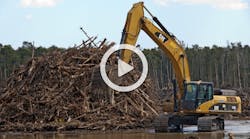The Global Water Crisis Invites Action, Discussion, and Feeling
When I’m not at work, and people ask me what I do for a living, mentioning Water Efficiency invites conversation. Even though this is an industry-specific magazine, there is not a person out there who isn’t ultimately a stakeholder in the kinds of things we report on. Look at media outlets that serve the general public and you’ll see water, water everywhere, as journalists tackle issues both global and local.
That makes it an exciting time for me. I am situated at this meeting point of a trade profession and the interests of the general populous. However, many of the stories circulating about water express concern, dismay, and even fear. We hear about water pollution, water supply impairments, terrible floods, and droughts. On January 15, Circle of Blue ran an article by Brett Walton, “World Economic Forum Ranks Water Crisis as Top Global Risk”. Walton writes: “For the first time, water crises took the top spot in the World Economic Forum’s tenth global risk report, an annual survey of nearly 900 leaders in politics, business, and civic life about the world’s most critical issues. Water ranked third a year ago. The report measured 28 risks on two dimensions: the likelihood of occurring within 10 years, and impact, which is a measure of devastation. Water ranked eighth for likelihood and first for impact.”
We’re fortunate that in our country, for the most part, problems continue to be met with solutions, ranging from the tried and true, to the highly innovative. Part of our job at Water Efficiency is to keep the solutions in view of water resource managers.
Our serene cover photo testifies to the proactive work being done in California’s Bay Area. It shows the filter beds at the Sunol Water Treatment Plant, part of the San Francisco Public Utilities Commission’s Hetch Hetchy Regional Water System. The plant, built in 1966, underwent a $140 million expansion and upgrade, insuring two months of supply for hundreds of thousands of customers. The San Jose Mercury News announced its completion in 2013, as part of SFPUC’s Water Services Improvement Program. WSIP, 10 years in the works as of 2014, is one of the biggest infrastructure improvement projects in the nation, funded by a bond measure that passed in 2002.
But bonds are not always seen as a good idea, and they do not always pass. One of our guest commentaries, “Challenges and Opportunity in the US Water Infrastructure Market” comes from Greg Powell of FMI Capital Advisors Inc. In addition to laying out the problem, Powell lists the federal programs initiated in 2014 to assist. He points out that the federal programs encourage private investment, too, suggesting this may be a way forward where municipal budgets are lacking, and response to need, both from government and water customers, is sluggish.
Going back to the alarm sounded by the World Economic Forum, the Circle of Blue article ends with some thoughts from Giulio Boccaletti, global director for water at The Nature Conservancy and a member of the World Economic Forum’s Global Agenda Council on Water. Boccletti notes that some regions, like Australia’s Murray-Darling Basin, have read the signs of the times and have been motivated to effectively address their water concerns.
“The World Economic Forum’s global risks report,” says Boccaletti, “is evidence that leaders elsewhere may be at a similar stage–ready to consider seriously the idea of water. What this report says is that leaders now recognize that they need to take care of water. It’s an opening to engage. We’re not necessarily ready to solve all problems. But politically, we’re at a stage to have a conversation about water and sustainable development.”
Discussion is important, as is action. And there are probably parts of the crises we face that need to be felt. We can discuss groundwater depletion in numerical terms, but we may not be moved to advocate for change unless, like Julene Bair, author of The Ogallala Road, interviewed in Ivy Anderson’s article “That Which We Depend On,” we spend time in places we have known and loved and find pleasure in the remaining resources, while nonetheless witnessing the degradation with open eyes. As I said at the beginning of this editor’s note, water flows not only in the trades that manage it, but also in all of our lives whether we are working or playing, always.




